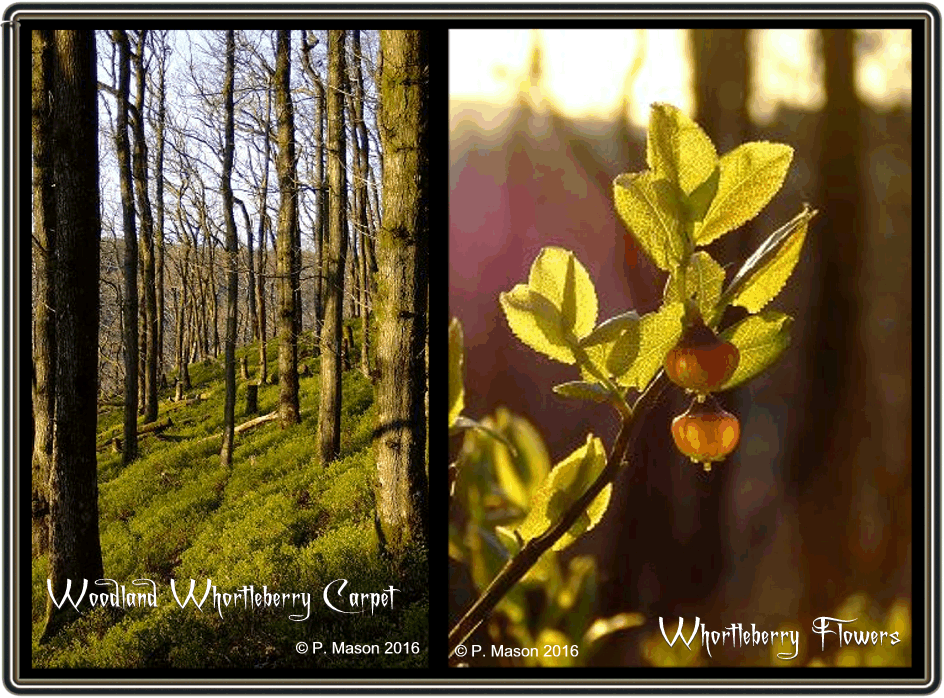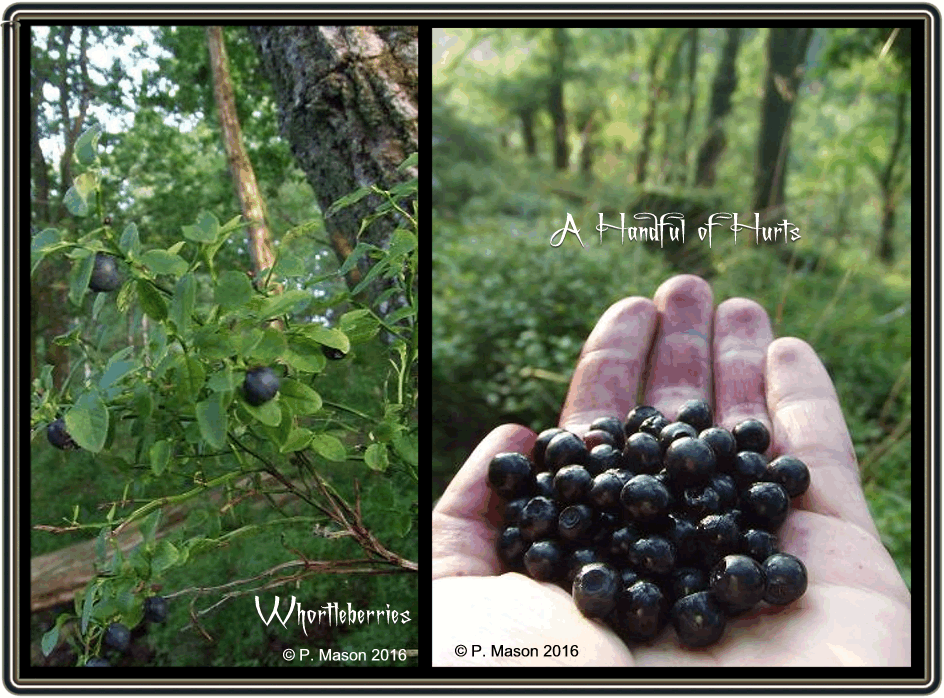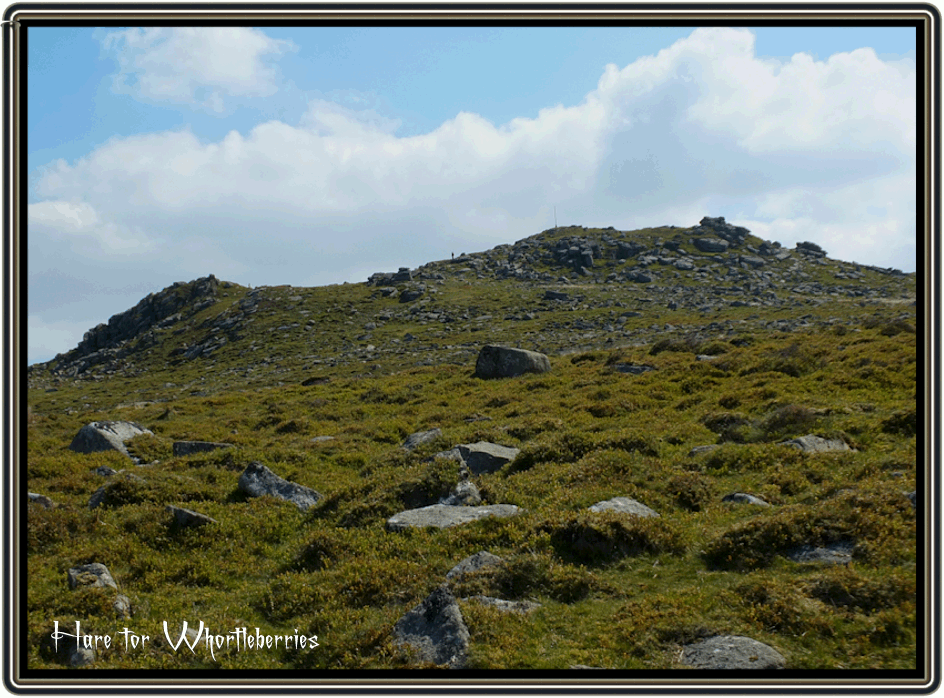
“To where the Whortleberries lure I hie,
Thinking of tasty whortleberry pie;
A most delightful, delicacy it
To set before the epicure is fit!
The picker’s task, maybe, is tedious,
Gathering the blue-black globules of the bush.
Now once again is whortleberry time,
Down westwards in our glorious summer climb,
And soon I hope the fruitful spot to make
So of that luscious tart I may partake,
Adding thereto of Devon’s richest cream,
And so fulfil the banquet of my dream!
Yea, whortleberry time is here! is here!
The tempting harvest of the Moorland’s Year!”
Mooroaman (F. Y. Symes – 1932).
At one time whortleberries or ‘Hurts‘ as they are known on Dartmoor were an important wild commodity gathered by the moorfolk either for sale or for personal use. As can be gathered from Mooroaman’s poem above they made a traditional and famous local pie which graced many a table. So much were they part of everyday life that a branch of the Baskerville family included them on their coat of arms. (Argent, a cheveron, gules between three Hurts).
Vaccinium mrytillus, in Scotland they call it a blaeberry, in Wales it is known as a whimberry, in England they are bilberries, in Devon they talk of whortleberries but on Dartmoor ‘tiz a ‘hurt‘. Call it what you want it tastes delicious and it is a chore to pick, you seem to spend hours plucking, squashing and eating them just to end up with a paltry amount. You probably will have scrabbled amongst granite boulders and have grazed half the skin off your hands but to compensate this you will have a treat in store.
For centuries moorfolk would have ‘gwain to moor, pickin’ hurts‘. This would have been treated as a sort of holiday and between July and early September small parties would be seen all over the moor. In some instances children would be kept away from school in order to go pickin’ hurts because if they came from a poor family the money earned was vital to the household income. In 1929 a man from Moretonhampstead was brought before the local sessions by the local attendance officer for regularly keeping his children away from school in order to pick whortleberries. In the man’s defence he said that; “The ten children, the missus and me sitting at a table is sufficient cause for keeping some home from school in order to help feed them.” By no means was this a singular occurrence as many poor families were in the same predicament. However in 1940 as part of the war effort school children were given various tasks to do during the first two weeks of the summer holidays and in Devon whortleberry gathering was one of them. In the August of that year it was reported that 1,812 pounds of whortleberries were picked by children in Devon. In some locations such was the popularity of collecting whortleberries that in certain woodlands a great deal of damage was done. In 1901 Mr. B. J. P. Bastard, the owner of Buckland Woods was so concerned with this matter that after consultation with the local clergy and ministers drew up a list of ‘respectable’ people who would be allowed access to his lands. In that year five women from Ashburton who were not on ‘the list’ were summonsed to appear the local petty sessions for unauthorised trespass, all pleaded guilty and were each fined three shilling and threepence plus damages.
When it came to reaping the ‘Purple Harvest’ the folk would set of early in the morning carrying baskets of all sizes and make for their favourite spots. Hook Lake, Stony Bottom, Omen Beam, Doe Tor Brook, Fox Holes, and Hare Tor were all places where the whortleberries thrived and in most cases still do. Years ago it was noted that parties of up to 500 pickers could be seen on Omen Beam. There were also various ways of collecting the berries; on the southern moor the norm would be to take a quart can and a large basket. The berries would be picked and placed in the can which when full would be transferred into the basket. This allowed the pickers to keep tally of how much they had picked and how much they had earned as the hurts were sold by the quart. On the northern side of the moor things weren’t quite so exact as the berries were put in a large basket and then weighed out on returning home. There was a traditional saying on Dartmoor before going whortleberrying; “The first I pick, I eat; The second I pick, I toss away; The third I pick, goes in my can.” – Crossing pp. 84 – 89. In Eden Phillpotts’ book ‘The River’, p.56 he writes; ” They came where the whortleberries grew on a southern facing hill. The shrub clothed the whole earth here, and, form its undergrowth, granite boulders arose in wild confusion. So well did the fruit prosper that many acres seemed brushed with purple. Autumn light was upon the hills and in the mottled scarlet and gold of their dying foliage the ripe berries still hung profusely. Now Hannah plucked off three, then very gravely utter certain words and performed actions proper to them as she pursued an ancient rite. The first I pick, I eat; The second I pick, I toss away; The third I pick, goes in my can.” It’s almost as if Phillpotts is suggesting that the rhyme was some kind of traditional charm for a successful harvest passed down through the generations of pickers?
As time progressed and with it the introduction of motorised transport saw increasing numbers of visitors coming to Dartmoor. No doubt some of them sampled the various homemade whortleberry delights and the know-how in making them. This then led to some of the more intrepid visitors joining the pickers in order to take home some of the ‘purple harvest’ to enjoy on their return. Back in 1903 The Western Morning News published a very evocative description of a day with the ‘hurt’ pickers – “A day with the hurt pickers – not as a gatherer, perhaps, for that exercise might be found rather tedious – is most enjoyable, especially if there happen to be some aged labourer among the party who has “heerd tell” of certain things that happened “years agone.” It is a picnic of the most unconventional character, and given sunny skies there is music in it from beginning to end. The picker leaves all his cares behind him – they are not usually very weighty ones – and gives himself up to the matter that has called him to the Moor. The more youthful of the party are in high spirits, and the merry prattle of children is heard through the livelong day. And nature comes forward to add to the pleasing sounds. An unseen songster carols overhead, and the stream sings to you from below. With all this ringing in your ears you scramble over grey boulders that the whortleberry plants partly hide, or take your ease upon some patch of short turf, hemmed in by tall bracken. By-and-bye the sun tells the gatherers it is time to start upon their homeward way, and with well-filled baskets they turn their faces towards the village that lies beyond the hill over which evening shadows are fast creeping. You reach home and rest, and in your dreams that night may perhaps are a group of women and children carrying baskets and threading their way between masses of rock, or passing knee-deep through heather. But whether you do or not, it is certain that your memory will never fail to carry you back to a certain happy day when you “went to Moor pickin’ hurts.”
There were some perils involved in whortleberry picking and probably the most common was for people getting lost. Often the trips up to the moor would involve a trek of six miles or more and so in some cases the men would act as ‘hurt guides’. However that was not always the case, in 1926 there was a newspaper report of a seventy year old lady who lived in the area of Drewsteignton and after a day picking hurts lost her way and finally after a five mile detour managed to find her way home. In 1916 a woman from Okehampton had a lucky escape whilst picking berries near Dinger Tor with her two dogs. She left home early in the morning but by that evening had not returned home. Friends and neighbours immediately began to search the area where she was known to favour for gathering her hurts. The search was hampered by a thick fog and just as the party were about to give up they heard some dogs barking. Thanks to the dogs the woman was found lying beside a rock unconscious, apparently the two dogs were sat beside the woman and at first would let no one near her. Fortunately they did finally relent and the woman was taken safely back to her home. By their nature the whortleberry plants thrive amongst the rocky tor sides of the moor and unless care was taken it was all too easy to turn or twist an ankle in the many hidden ‘caves’ amongst the clitters. Another danger was always the possibility of finding and adder secreted amongst the whortleberry plants and should a hand be placed near it then the chances of being ‘stung’ were quite high. In 1901 a woman from Princetown was stung twice by a viper whilst picking whortleberries, fortunately she made it back to Princetown where the prison doctor attended her. Apparently she fell unconscious for several hours during which time her arm from the shoulder to the fingers turned black and swollen. In 1912 a man from Okehampton was stung in the arm by an adder whilst hurt picking, at first he just ignored the matter but when his finger began to swell and turned black he immediately went to the military hospital at Okehampton camp where his finger was amputated. The Dartmoor weather was also another hazard faced by the pickers with the perils of sudden dense fogs and lightening storms to name but a few.
In later years there was the problem of unexploded ordnance on the military ranges especially the whortleberry spots on the Wilsworthy and Merrivale ranges, Doe Tor etc. A newspaper report from 1929 highlighted said perils; “In old days at Okehampton, and probably still, one of the difficulties of those responsible for the artillery practice was the clearing of the ranges, not only of ponies but also of tourists and other human wanderers. I remember well one day descrying moving figures among the dummies just as a battery was about to open fire on them. As I turned to order the raising of the danger screen, the old shepherd who was responsible for the clearing of the range shouted excitedly: “Shoot sir, shoot – they be only whortleberry pickers.” Before sheep dipping regulations were put in place pickers were told to avoid areas when sheep who had just been dipped were grazing. This was due to the fact that the early dips contained arsenic and there was a possibility that sheep with wet fleeces may rub or drop some of the dip which remained in the fleece onto the berries. Those in poor health were (and still are) at risk when venturing onto the moor and in 1923 a man from Plymouth suffered a heart attack whilst gathering whortleberries near Great Links Tor.
Those berries that were not for sale would be used in various guises in the home, as noted above, they were used in making the traditional whortleberry pie. Along with the pies tarts, jams and jellies were also produced along with ‘Hurt Gin’ which was made in the same manner as sloe gin but with an acquired taste. However those were not their only uses, in the 1700s one herbalist wrote the following; “It is a pitty they are used no more in Physick than they are. The black bilberry are good in hot agnes. The juyce made into a syrup or the pulp made into a conserve is good for an old cough or ulcer in the lungs or other diseases.” During the First World War the berry juices were used to produce a dye which was used in the making of army uniforms. The various food shortages during the Second World War led in some cases for whortleberries being used in baking as a substitute for sultanas and currents. There is one other ‘recipe’ which includes ‘hurts’ although today may not be legal. It involves taking two or three of the red capped Fly Agaric mushroom and then steeping it in whortleberry juice and then making them into boluses. The effect being akin to drinking a bottle or two of wine – “A day’s intoxication proceeds this singular recipe… and this intoxication is affirmed to be not only cheap but remarkably pleasant. The result follows within an hour or two of participation.” Pleas note – Fly agaric is poisonous and infamous for its psychoactive and hallucinogenic properties.
By the 1930s the whortleberry ‘industry’ was in decline for several reasons. Firstly it can take several seasons for the plant to reach the fruit bearing stage and the continued increase in ‘swaling’ or burning of the heather etc had a detrimental effect on the crop. Secondly it was said that the introduction of the Scotch Black Face sheep also led to the decline in whortleberry cover due to their fondness of the young shoots. The actual market for whortleberries also saw a sharp decrease as the large quantities needed for making the dye for First World War uniforms were no longer needed. This was further compounded by the introduction of synthetic dyes. On occasions gorse fires would also decimate the whortleberry grounds which again took several years to recover. In some instances the fires would have been started accidentally by whortleberry pickers. In 1913 one such fire spread through to a plantation near Widecombe renown for being a fox covert which caused a great deal of damage and upset to the local hunting fraternity.
Every season the berry yields would very from heavy to light depending on how wet the year had been and indeed how cold it was. Damp conditions and harsh frosts could dramatically affect both the weight and size of the crops. So there would be good years where the pickers made a substantial amount of money as well as very light years where little to hardly anything was made. Such was the importance of whortleberries to the local economy that most of the regional newspapers regularly published their current market prices and reports as to each year’s harvest. Very often these early forecasts were the signal for folk to go scurrying up to their favourite whortleberry grounds. Each year the prices fetched would vary according to the crop and other external factors such as the two World Wars. In the 1890s hurts were fetching four pence a quart, in the 1900s the average was six pence a quart, in the 1910s the price started off at five pence a quart in 1910 but rose to one shilling a quart in 1914 (as explained above for use in First World War uniform dyes and a food replacement). From the 1920s onwards the berries were sold by the pound and in that decade the average price was one shilling a pound. The 1930s saw a slight drop in price to nine pence a pound but by the mid 1940s there was a dramatic rise to two shillings and six pence a pound, again due to the Second World War. The problem with comparing these prices is that it is difficult to convert quarts into pound as the former is a measure of volume and the latter weight. Therefore it is necessary to know the exact volume of whortleberries in order to make the conversion. Even so these figures clearly show the seasonal fluctuation of the whortleberry crops.

Crossing, W. 1966. The Dartmoor Worker. Newton Abbot: David & Charles.
 Legendary Dartmoor The many aspects past and present of Dartmoor
Legendary Dartmoor The many aspects past and present of Dartmoor



